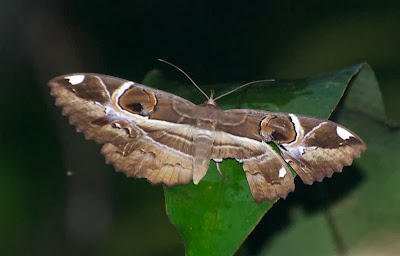When night fell during our October 2012 course for birding guides at Kubah National Park, we were free to don our headlamps and scout around for the nocturnal inhabitants of the forest (not, I fear, including night birds). Our chief target was the frog pond and the boardwalk around it, but the frogs themselves deserve their own post and will get it (well, two posts, actually, as you will see). Here I will concentrate on the non-frogs,some of which were day-flying insects simply trying to get a night's sleep. This is one of them, a Banded Marquis (Euthalia [or Bassarona] teuta bellata), a butterfly I have never been sure of seeing by day. Here it is, though.
We were more likely to turn up genuine night-haunters, like this katydid nymph....
...or one of Borneo's spectacular stick insects.
This peculiar object appears to be an ant colony (or, at least, it has attracted one).
Moths were conspicuous (thanks to their particularly bright eyeshine), abundant, and diverse.
I would love to be able to tell you what these are, but my attempts at identification have proved sorry failures. Can anyone help?
It is particularly galling not to be able to name a moth as large and spectacular (even if damaged) as this one, though I suspect it is some sort of silk moth (Saturniidae).
I feel less guilty about something like this nicely-camouflaged moth (well, it would be nicely camouflaged on a tree) on the wall of the park headquarters.
This little green moth is quite common, but once again all I have been able to find are photographs of, presumably, the same species on the internet, unhelpfully labelled "green moth".
As happens almost everywhere in the humid tropics, lit-up walls attracted geckos (or, perhaps better, it attracted insects which the geckos ate). This one is a Spotted House Gecko (Gekko monarchus).
Back in the forest near the frog pond, I came across this extremely attractive snail navigating through the shrubbery at, fortunately, eye level.
My thanks to Gary Rosenberg for identifying this little beauty as as Leptopoma undatum. Leptopoma is an operculate snail, meaning it has an operculum, a horny plate it can use to seal off the opening of its shell (it's the object resembling a large fingernail sticking out of the back of the shell). The species is endemic to northern Borneo.
Nocturnal mammals are not easy to come across in Borneo. I was delighted when we came across this one on the roadside just across from the frog pond, even if it was only a mouse.
Mind you, when I say "only" I am being rather facetious. It is, in fact, not just any mouse but a Pencil-tailed Tree Mouse, one of three very similar Bornean rainforest mice in the south-east Asian genus Chiropodomys. Notice the brush-like (or "pencil-like") tip to the tail. Also notice the very long tail and immense faceful of whiskers, both presumably adaptations for balancing and feeling one's way through the trees.
Of course I wanted to know which of the three Bornean species this one might be, so I wrote Quentin and Karen Phillips. Their view is that, of the three Bornean species, this is either the Small (or Common, or Lesser) Pencil-tailed Tree Mouse (Chiropodomys pusillus) or the Large (or Greater) Pencil-tailed Tree Mouse (Chiropodomys major) (the third species is known only from Mount Kinabalu in Sabah). The two differ mostly by size, and you can't tell that from a photo (except that the Lesser prefers bamboo, and this one isn't in bamboo, so the Greater may be the more likely). Not surprisingly, not much seems to be known about either of them.
Anyway, it was a delightful little animal, and a highlight of our weekend in Kubah.

![Banded Marquis (Euthalia [Bassarona] teuta bellata) Banded Marquis (Euthalia [Bassarona] teuta bellata)](https://blogger.googleusercontent.com/img/b/R29vZ2xl/AVvXsEgmxcBWmJ0FkaKu-GcFLHOc5Ea1KrYZeOFyBcezdlEr4WKBPg3G1Ew2vc-ExRVB3yScf88cL688zM_H728Wqx8YlrnoqwTFeh3VplimdoNR6JPpwV3PDDHXdnRQiRuTuy8JEtcz67hduwix/s400/Banded+Marquis+(Euthalia+%5BBassarona%5D+teuta+bellata)+DSC_4825.jpg)














+DSC_5122.jpg)
+DSC_5123.jpg)
+DSC_5118.jpg)
+DSC_5121.jpg)
No comments:
Post a Comment